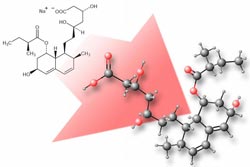The computer recognizes chemical structures

chemoCR® makes chemical information contained in depictions of chemical structures accessible for computer programs. Grafik: Fraunhofer-Institut SCAI
Scientists at the Fraunhofer Institute for Algorithms and Scientific Computing (SCAI) in Sankt Augustin have developed software that is able to recognize images of chemical structures. The tool also re-builds the structures and converts them into a computer-readable format. In the future, this innovative solution, “chemoCR”, will be developed further, and marketed together with InfoChem GmbH, a chemoinformatics company based in Munich.
Computerized indexing of chemical structure images is one of the biggest challenges in chemical and pharmaceutical research. Publications and patents contain structures mainly as pictures. This is no problem for chemical scientists: a quick look usually enables them to classify the chemical structure. However, for a computer, such pictures are nothing else but an accumulation of pixels.
Pictures representing chemical structures can be found in large repositories of scientific publications and in millions of patents. With the chemoCR software it is now possible, for the first time, to transform this graphically encoded chemical information into the formats used for “live” chemical structures. This enables computers to retrieve information contained in chemical-pharmaceutical patents, by performing structure searches.
“We have invested three years' work in this research and development project and are very encouraged by the high level of interest expressed by the chemical and pharmaceutical industry”, says Dr. Marc Zimmermann, responsible for the development of chemoCR at the Fraunhofer Institute SCAI. “Cooperation with InfoChem is a milestone in the marketing of the software. InfoChem is a well established partner of the chemical and pharmaceutical industry, worldwide, in the field of chemical information.”
Both partners are excited by the potential of chemoCR. “Up to now, structures have been drawn by chemists in India, Russia and other low-wage countries, and entered manually in databases. These fast developing countries are benefiting from the added indexing value. With chemoCR we can now reconstruct chemical structures faster and more cost-effectively, with computers”, emphasizes Dr. Peter Loew, InfoChem's CEO.
“With our software, for the first time, millions of patents can be searched using the chemical information contained in the pictures. This opens new possibilities for the investigation of patent claims on compounds and synthesis procedures; chemoCR addresses one of the most common challenges of the chemical and pharmaceutical industry”, adds Prof. Dr. Martin Hofmann-Apitius, Director of the Bioinformatics Department at Fraunhofer Institute SCAI.
About Fraunhofer SCAI
The Department of Bioinformatics at the Fraunhofer Institute for Algorithms and Scientific Computing SCAI is doing applied research and development in three main fields: information extraction; semantic text analysis, applied chemoinformatics and datagrid; and grid infrastructure. The Department of Bioinformatics is working closely with industrial partners, including small and medium sized enterprises, to enhance their competitiveness through mediating knowledge and technology transfer from academic research to industrial application. Collaborative research and development projects of the Department of Bioinformatics deliver solutions to the pharmaceutical industry, the biotech industry and to the life science software industry.
About InfoChem
InfoChem GmbH (www.infochem.de), based in Munich, Germany, is a market leader in structure and reaction handling and retrieval. Founded in 1989, InfoChem focuses on the production and marketing of new chemical information products, including structural and reaction databases and the development of software tools required for these applications. The main software tools provided are the InfoChem Fast Search Engine (ICFSE), the InfoChem Chemistry Cartridge for Oracle (ICCARTRIDGE), the reaction center identification tool ICMAP and the widely used InfoChem reaction classification algorithm CLASSIFY. In addition, InfoChem distributes one of the largest structural and reaction files worldwide, currently containing 6 million organic and organometallic compounds and facts and 4 million reactions covering the chemical literature published since 1974 (SPRESI). InfoChem's customers are large chemical and pharmaceutical companies as well as small high-potential start-ups worldwide, and major publishers. Springer-Verlag (Heidelberg) has held a majority interest in InfoChem since 1991.
CONTACTS:
Prof. Dr. Martin Hofmann-Apitius
Director Bioinformatics Department
Fraunhofer Institute for Algorithms and Scientific Computing (SCAI)
Schloss Birlinghoven, 53754 Sankt Augustin
Email: martin.hofmann-apitius@scai.fraunhofer.de
Telephone: +49 (0)2241 14 2802, Fax: +49 (0)2241 14 2656
Dr. Valentina Eigner Pitto
InfoChem GmbH
Landsberger Strasse 408 / V, 81241 Munich
Email: ve@infochem.de
Telephone: +49 (0)89 583002, Fax: +49 (0)89 5803839
Media Contact
All latest news from the category: Information Technology
Here you can find a summary of innovations in the fields of information and data processing and up-to-date developments on IT equipment and hardware.
This area covers topics such as IT services, IT architectures, IT management and telecommunications.
Newest articles

Properties of new materials for microchips
… can now be measured well. Reseachers of Delft University of Technology demonstrated measuring performance properties of ultrathin silicon membranes. Making ever smaller and more powerful chips requires new ultrathin…

Floating solar’s potential
… to support sustainable development by addressing climate, water, and energy goals holistically. A new study published this week in Nature Energy raises the potential for floating solar photovoltaics (FPV)…

Skyrmions move at record speeds
… a step towards the computing of the future. An international research team led by scientists from the CNRS1 has discovered that the magnetic nanobubbles2 known as skyrmions can be…





















